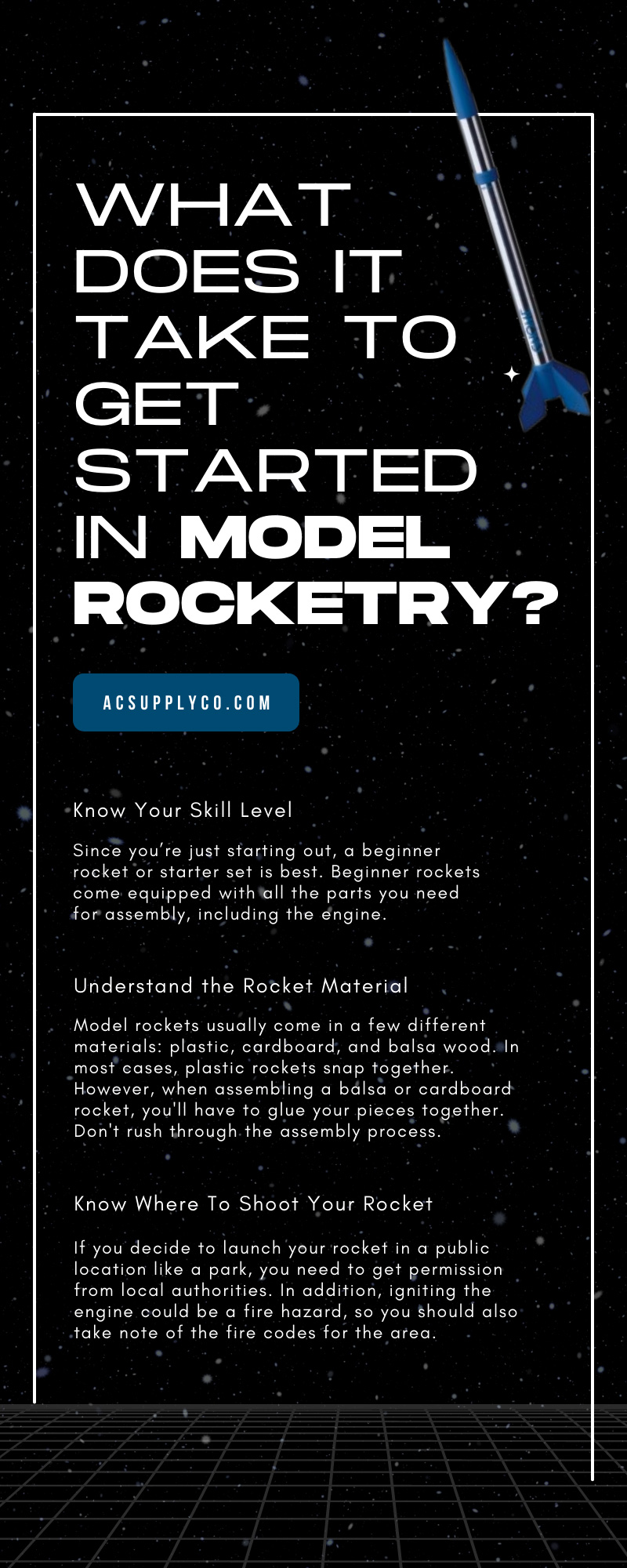Hobbies are a great way to decompress while also fueling your knowledge. If you love all things space, building rockets is an ideal choice. This gives you a chance to assemble your rocket with hands-on learning, and then see it launch. Read up on what you need to know about model rockets as you leap into this activity!
Know Your Skill Level
So, what does it take to get started in model rocketry? It requires a few things. But first and foremost, you need to know your skill level. Since you’re just starting out, a beginner rocket or starter set is best. Beginner rockets come equipped with all the parts you need for assembly, including the engine. Building a rocket within your skill level keeps things fun—nothing's more frustrating than trying to make sense of instructions you don't understand.
As you invest more time into this hobby, you'll move up the ranks. Once you've mastered a Level 0 rocket, you can go to Level 1, and before you know it, you'll be a pro!
Can Kids Do This Hobby?
Of course! Children ten and up love building model rockets. It's a wonderful way to teach them about STEM. Learning about STEM (Science, Technology, Engineering, Math) at a young age improves a child’s education in a fun setting. This is a great chance to talk about aerospace, but it also gets kids building like engineers. Many teachers and camps add this activity to their curriculum. You can just as easily do it at home.
Skill Level and Time
Beginner-level rockets usually take around an hour or less to assemble. However, the time it takes could vary depending on age and where you are. For example, it may take longer for a student to build a rocket in the classroom than at home with a parent's help. Building a pro-level rocket could take days since they are more complex, and the instructions have more details. This is also why buying a kit according to your skill level is important.
Building Model Rockets
Model rocket kits come with quite a few parts that you'll need to assemble carefully. The pieces in your kit may vary depending on your skill level since higher-level rockets don't always come with an engine. Most beginner kits come with the following:
- Nose cone
- Shock cord
- Shroud lines
- Parachute
- Body tube
- Fins
- Engine hook
- Engine mount
Keep in mind that often higher-level kits—and sometimes beginner kits—require you to buy a launch pad and a launch controller separately. As you shop for your rocket, read through the product description to see what it comes with.
While it may sound obvious, follow your rocket's instructions while assembling it. It can be easy to skip ahead, but this could lead to a poor assembly. And a poor build could lead to an issue when it comes time to launch.
Just like a real rocket, the model ones propel into the air once you ignite the engine, and the parachute will release as it comes down.
The Tools You'll Need
Luckily, most model rockets don't require any special tools that you must rush out and purchase. Most of the time, you'll need some glue, a ruler, a pencil, and sandpaper to build the rocket. Make sure you have masking tape, paint, and brushes to paint your rocket.
How High Do They Go?
Your rocket's height depends on the size, weight, and engine power. While some model rockets shoot hundreds of feet into the air, others can go thousands. A heavy rocket with a weak engine may not go too high, but if that heavier rocket has the appropriate power engine, it should launch hundreds or thousands of feet.
Understand the Rocket Material
Model rockets usually come in a few different materials: plastic, cardboard, and balsa wood. In most cases, plastic rockets snap together. However, when assembling a balsa or cardboard rocket, you'll have to glue your pieces together. Don't rush through the assembly process. This isn't a race against the clock. Taking your time means doing things right.
Pro Tip
You'll need to remove the nose cone as you paint your rocket. By leaving it on as you paint, you risk getting it stuck to the body of your rocket. You don't want issues to arise when it comes time to launch. You especially don’t want a failed parachute.
Know Where To Shoot Your Rocket
You can't shoot off your rocket just anywhere. You'll need plenty of open space so that the rocket can reach its full height. This means you likely won't be able to launch the rocket in your backyard, especially if you have a small space or a lot of trees.
If you decide to launch your rocket in a public location like a park, you need to get permission from local authorities. In addition, igniting the engine could be a fire hazard, so you should also take note of the fire codes for the area.
Prioritize Safety
If you launch your rocket in a public area, safety is key. Read through the National Association of Rocketry's recommendations so that you can keep this activity fun and safe. In addition to this, you should only use certified motors and keep the surrounding area clear during a launch. Sometimes, misfires happen, which could lead to injury if anyone is too close to the rocket.
Shop for Quality Rockets
When you first asked yourself, "what does it take to get started in model rocketry?" you may not have expected all this vital information. Our final bit of advice is one more thing to think of as your buy your first rocket—shop for quality.
Shop at AC Supply
AC Supply is a rocket hobby supplierwith model rockets for every skill level plus all the components you'll need! We sell Estes model rockets because quality is every buyer's priority. Search out your favorite rocket within your skill level so you can begin this exciting hobby!



